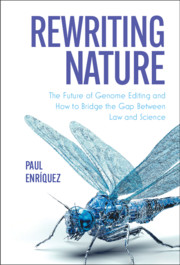Book contents
- Rewriting Nature
- Rewriting Nature
- Copyright page
- Dedication
- Summary of Contents
- Contents
- Figures
- Foreword
- Acknowledgments
- Table of Cases
- Abbreviations
- 1 A Momentous Time for Humankind
- 2 How an Idea Became a Reality
- 3 What Is Genome Editing?
- 4 Molecular Paraphernalia
- 5 What Can Genome Editing Be Used for?
- 6 Redesigning Food
- 7 Regulating Bioengineered Food
- 8 Redesigning Humanity
- 9 DNA and the Administrative State
- 10 Constitutional Predicaments
- 11 Science, Law, and Policy
- 12 Epilogue
- Index
7 - Regulating Bioengineered Food
Published online by Cambridge University Press: 11 June 2021
- Rewriting Nature
- Rewriting Nature
- Copyright page
- Dedication
- Summary of Contents
- Contents
- Figures
- Foreword
- Acknowledgments
- Table of Cases
- Abbreviations
- 1 A Momentous Time for Humankind
- 2 How an Idea Became a Reality
- 3 What Is Genome Editing?
- 4 Molecular Paraphernalia
- 5 What Can Genome Editing Be Used for?
- 6 Redesigning Food
- 7 Regulating Bioengineered Food
- 8 Redesigning Humanity
- 9 DNA and the Administrative State
- 10 Constitutional Predicaments
- 11 Science, Law, and Policy
- 12 Epilogue
- Index
Summary
The advent of recombinant DNA technology in the 1970s led to general concerns about the use of novel biotechnologies and the potential effects on public health and the environment. To assuage those concerns, the Reagan Administration created the Coordinated Framework for the Regulation of Biotechnology. This 1986 policy document avowed that existing health and safety laws could provide adequate regulatory oversight for biotechnology products under a products-based, rather than a process-based, approach and assigned broad federal jurisdiction to the FDA, EPA, and USDA. This chapter examines how novel genome-editing technologies will test the limits of the Coordinated Framework, which is largely limited in scope by older genetic-engineering methods. The chapter analyzes the regulatory status of gene-edited crops and how, under specific circumstances, these crops can escape regulatory oversight due to the Coordinated Framework’s focus on the use of transgenic DNA to carry out the intended genetic manipulations. The chapter explores current regulatory gaps and argues that, in the near future, it will likely be increasingly cumbersome to distinguish between genome-edited crops and naturally occurring crops. The technology, therefore, is likely to challenge the very essence of what constitutes a GMO and extends opportunities to help allay controversies surrounding genetically modified crops.
Keywords
- Type
- Chapter
- Information
- Rewriting NatureThe Future of Genome Editing and How to Bridge the Gap Between Law and Science, pp. 244 - 263Publisher: Cambridge University PressPrint publication year: 2021



